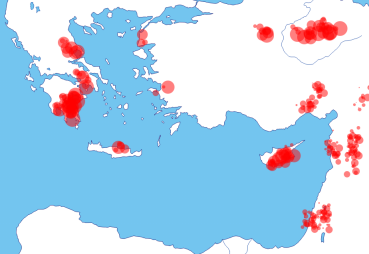I started reading Drew’s book on the c.1200 BCE catastrophe over the weekend. So far he has been reviewing the archaeological data concerning which sites were destroyed. Basically the map shows that a whole slew of cities and palaces were sacked and for the most part throughly burned in:
- mainland Greece
- modern Turkey, both the coastal regions round Troy and Miletus and the Anatolian Hittite regions
- modern Syria, both along the coast and further inland
- Cyprus
- modern Lebanon and parts of Israel and Jordan, in particular the coastal plain and down the Jordan valley

Literally dozens of settlements of varying sizes were burned and the inhabitants scattered, all within what seems to be a time span of 30 or 40 years. . In some cases the places were resettled not long after, but in others the abandonment was longer term – for example Ugarit was never resettled, and was lost to memory until recent times.
The archaeological evidence is not exact enough to say that all these destructions had the same cause, nor the sequence in which they happened, but he argues on both logical grounds and from the Egyptian texts that the movement was north-to-south.
The destruction pattern washes around but does not really touch the southern hill country of modern Israel and Palestine, and he specifically mentions Jerusalem and Gibeon as places which were untouched. This is handy for my overall storyline, as these places – under the names of Shalem and Giybon – feature strongly.
Drews’ overall question is, I think, fascinating. The destruction of cities and palaces, whilst always terrible for the occupants, often does not signal major social change or the collapse of the culture – in many cases the destruction spurs off a new flourishing of building work and other cultural activities. But all around the Levant these events were truly catastrophic. The Bronze Age social structures and connections collapsed, and were uniformly replaced by other forms. Why should this have happened?
I have not yet read far enough to see what his answer is, but since he is an advocate of the ‘new military technology’ approach, my guess is that he will suggest that the new styles of warfare swept the former military elites away. This would make the change comparable in some ways to the demise of the mounted armoured knights of the medieval period. The advent of the longbow and then gunpowder not only changed the course of battles, but also signalled much wider social transformations. When the dust of the 1200 BCE catastrophe had settled, the new kingdoms that arose all around the eastern Mediterranean were built on different principles.
